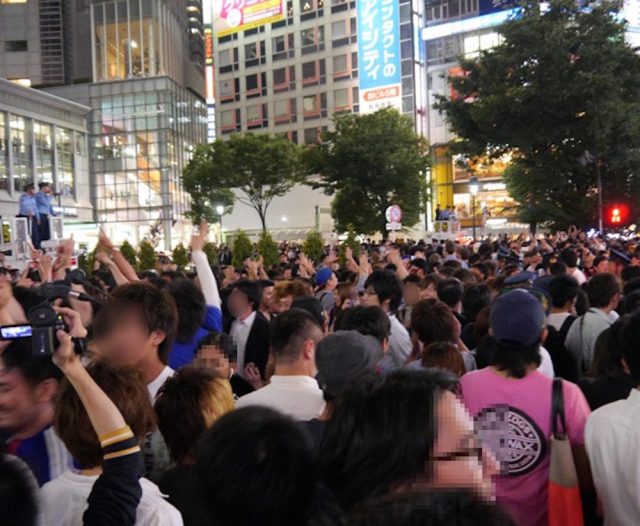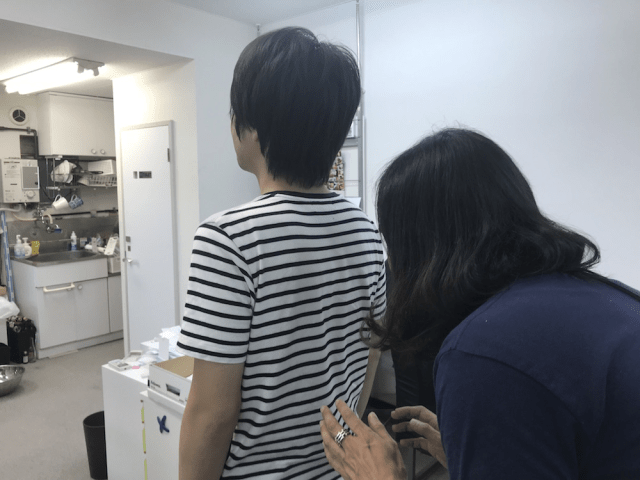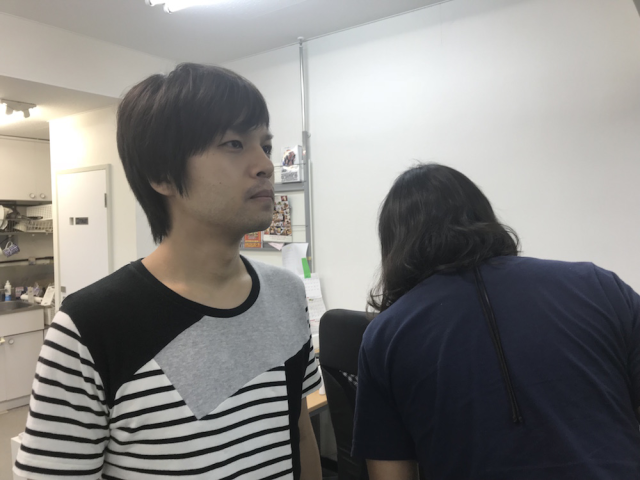
Being in the biggest city in Japan means you’re probably sharing the walkway with more people than you’d like, but here’s how to make things easier.
Tokyo is an easy town to get around, in the sense that there are dozens of train and subway lines crisscrossing the city with reliable, affordable rail service. But sometimes it’s not such an easy town to get around once you get off those trains, because when you step out of the station you might be stepping directly into a sidewalk-clogging mass of humanity.
Navigating Tokyo comfortably requires you to not only be familiar with the closest station and exit to your desired destination, but also how to walk through the crowds of other people you’re sharing pedestrian pathways with. Thankfully, our reporter Takashi Harada, who grew up in Fukuoka (which, even with a population of 1.5 million residents, pales in comparison to Tokyo’s 13.6 million) has developed a few strategies since moving to Japan’s capital, and below are his five recommended techniques for speedy, stress-free striding through Tokyo.
1. The slipstream
The first step to becoming a better walker is, ironically, to pretend you’re a car. Much like how racers draft behind opponents to reduce wind resistance, by staying close behind someone who’s headed in the same direction as you are you can take advantage of the pocket of empty space that’s directly behind them, as long as you follow closely enough that the rest of the crowd hasn’t filled in the void.
In particular, Harada recommends walking behind successful salarymen in their 40s or 50s, who tend to wear suits and walk with broad-shouldered confident posture, thus cutting a comparatively wide path through the crowd. Conversely, he cautions men using the slipstream technique against following closely behind a woman, since it might look like you’re trying to stalk her.
2. The basketball player
Of course, not everyone is pointing their feet towards the same goal as you are. Some of them are going to be moving in the opposite direction, and in a large enough crowd, at some point you’ll probably find yourself and someone else heading right towards each other.
At these times, Harada recommends taking light yet quick and decisive steps, like a basketball player trying to sidestep an opponent. If you stop and shuffle your feet, the other person will probably do the same and you’ll end up mirroring each other so that neither one of you can make any forward progress.
3. The shoulder signal
OK, but what if you and someone else do end up stopped and facing one another in a crowd? In that case, one of the easiest ways to signal your intended course is by tiling your shoulders in the direction you want to go. Sure, you could point or extend a hand, but that riskes the miscommunication of whether you’re gesturing to say “I’m going this way” or to tell the other person “Please, go this way.” The shoulder tilt also takes up less space than using your whole arm to point.
Remember, while the tilt needs to be large enough to be noticeable, it should still be small and momentum-free enough that it doesn’t become a full-on lunge.
4. The detour
There’s a Japanese saying, “Isogaba maware,” which is sometimes translated as “Slow and steady wins the race.” Literally, though, “Isogaba maware” means “If you’re in a hurry, go around,” indicating that the absolute direct route isn’t always the fastest.
When plotting a walking route in downtown Tokyo, the biggest streets are always going to be the most crowded, so sometimes you might actually be better off cutting over a block and taking a smaller, parallel road, then heading back onto the main street only when you have to. Not only will you be able to walk more quickly because of the lack of crowds, you might even find something you never would have otherwise on your trip off the beaten/crowded path.
5. The people you’ll want to avoid
Finally, it’s important to remember that even though you’re focused on getting to your destination, other people walking through the crowd might be more focused on their smartphones. Despite some innovative attempts to raise awareness of the dangers of fiddling with your phone while walking, you’ll still find a number of misguided multitaskers in any large group of pedestrians, and they’re the ones most likely to bump into you or someone else, creating a chain reaction pileup that ripples out far around them. As such, you’ll want to keep an eye out for them and give them a wide berth, at least until the Tokyo Metropolitan Government approves the use of ninja murder squads to punish people for using their phones in this manner.
Photos ©SoraNews24
[ Read in Japanese ]
Follow Casey on Twitter, where whenever he has to walk through a crowd, he imagines that he’s playing a bullet hell shooter.
[ Read in Japanese ]



 Say hello to Japan’s new generation of adults, fresh from Kitakyushu’s seijinshiki ceremony
Say hello to Japan’s new generation of adults, fresh from Kitakyushu’s seijinshiki ceremony What’s it like traversing Tokyo using only wheelchair accessible routes?
What’s it like traversing Tokyo using only wheelchair accessible routes? 10 of our absolute favorite places to spend a day in Tokyo
10 of our absolute favorite places to spend a day in Tokyo Butsukariya: Men who purposely crash into women when walking through Japan’s crowded stations
Butsukariya: Men who purposely crash into women when walking through Japan’s crowded stations Japan’s number one cosplayer Enako wows crowds at Halloween event in Tokyo
Japan’s number one cosplayer Enako wows crowds at Halloween event in Tokyo Foreigner’s request for help in Tokyo makes us sad for the state of society
Foreigner’s request for help in Tokyo makes us sad for the state of society Japanese city loses residents’ personal data, which was on paper being transported on a windy day
Japanese city loses residents’ personal data, which was on paper being transported on a windy day Historical figures get manga makeovers from artists of Spy x Family, My Hero Academia and more
Historical figures get manga makeovers from artists of Spy x Family, My Hero Academia and more Akihabara pop-up shop sells goods made by Japanese prison inmates
Akihabara pop-up shop sells goods made by Japanese prison inmates New private rooms on Tokaido Shinkansen change the way we travel from Tokyo to Kyoto
New private rooms on Tokaido Shinkansen change the way we travel from Tokyo to Kyoto Suntory x Super Mario collaboration creates a clever way to transform into Mario【Videos】
Suntory x Super Mario collaboration creates a clever way to transform into Mario【Videos】 Japan’s massive matcha parfait weighs 6 kilos, contains hidden surprises for anyone who eats it
Japan’s massive matcha parfait weighs 6 kilos, contains hidden surprises for anyone who eats it Anime girl English teacher Ellen-sensei becomes VTuber/VVTUber and NFT
Anime girl English teacher Ellen-sensei becomes VTuber/VVTUber and NFT One-of-a-kind Osaka-themed Uniqlo Shinsaibashi opens
One-of-a-kind Osaka-themed Uniqlo Shinsaibashi opens Starbucks Japan adds a Motto Frappuccino to the menu for a limited time
Starbucks Japan adds a Motto Frappuccino to the menu for a limited time McDonald’s new Happy Meals offer up cute and practical Sanrio lifestyle goods
McDonald’s new Happy Meals offer up cute and practical Sanrio lifestyle goods Japanese ramen restaurants under pressure from new yen banknotes
Japanese ramen restaurants under pressure from new yen banknotes French Fries Bread in Tokyo’s Shibuya becomes a hit on social media
French Fries Bread in Tokyo’s Shibuya becomes a hit on social media Studio Ghibli releases new action figures featuring Nausicaä of the Valley of the Wind characters
Studio Ghibli releases new action figures featuring Nausicaä of the Valley of the Wind characters Red light district sushi restaurant in Tokyo shows us just how wrong we were about it
Red light district sushi restaurant in Tokyo shows us just how wrong we were about it Tokyo Tsukiji fish market site to be redeveloped with 50,000-seat stadium, hotel, shopping center
Tokyo Tsukiji fish market site to be redeveloped with 50,000-seat stadium, hotel, shopping center All-you-can-drink Starbucks and amazing views part of Tokyo’s new 170 meter-high sky lounge
All-you-can-drink Starbucks and amazing views part of Tokyo’s new 170 meter-high sky lounge Beautiful Ghibli sealing wax kits let you create accessories and elegant letter decorations【Pics】
Beautiful Ghibli sealing wax kits let you create accessories and elegant letter decorations【Pics】 Studio Ghibli releases Kiki’s Delivery Service chocolate cake pouches in Japan
Studio Ghibli releases Kiki’s Delivery Service chocolate cake pouches in Japan New definition of “Japanese whiskey” goes into effect to prevent fakes from fooling overseas buyers
New definition of “Japanese whiskey” goes into effect to prevent fakes from fooling overseas buyers Our Japanese reporter visits Costco in the U.S., finds super American and very Japanese things
Our Japanese reporter visits Costco in the U.S., finds super American and very Japanese things Studio Ghibli unveils Mother’s Day gift set that captures the love in My Neighbour Totoro
Studio Ghibli unveils Mother’s Day gift set that captures the love in My Neighbour Totoro More foreign tourists than ever before in history visited Japan last month
More foreign tourists than ever before in history visited Japan last month New Pokémon cakes let you eat your way through Pikachu and all the Eevee evolutions
New Pokémon cakes let you eat your way through Pikachu and all the Eevee evolutions Sales of Japan’s most convenient train ticket/shopping payment cards suspended indefinitely
Sales of Japan’s most convenient train ticket/shopping payment cards suspended indefinitely Sold-out Studio Ghibli desktop humidifiers are back so Totoro can help you through the dry season
Sold-out Studio Ghibli desktop humidifiers are back so Totoro can help you through the dry season Japanese government to make first change to romanization spelling rules since the 1950s
Japanese government to make first change to romanization spelling rules since the 1950s Ghibli founders Toshio Suzuki and Hayao Miyazaki contribute to Japanese whisky Totoro label design
Ghibli founders Toshio Suzuki and Hayao Miyazaki contribute to Japanese whisky Totoro label design Doraemon found buried at sea as scene from 1993 anime becomes real life【Photos】
Doraemon found buried at sea as scene from 1993 anime becomes real life【Photos】 Tokyo’s most famous Starbucks is closed
Tokyo’s most famous Starbucks is closed One Piece characters’ nationalities revealed, but fans have mixed opinions
One Piece characters’ nationalities revealed, but fans have mixed opinions We asked a Uniqlo employee what four things we should buy and their suggestions didn’t disappoint
We asked a Uniqlo employee what four things we should buy and their suggestions didn’t disappoint Princesses, fruits, and blacksmiths: Study reveals the 30 most unusual family names in Japan
Princesses, fruits, and blacksmiths: Study reveals the 30 most unusual family names in Japan 18 awesome overnight hot spring trips from Tokyo, and a quiz to help pick the best one for you
18 awesome overnight hot spring trips from Tokyo, and a quiz to help pick the best one for you We spend an afternoon in the park with the King of the Monsters at Kurihama’s Godzilla Slide
We spend an afternoon in the park with the King of the Monsters at Kurihama’s Godzilla Slide Tokyo’s new sleep-inducing “time machine” head massage parlor looks like steampunk/sci-fi day spa
Tokyo’s new sleep-inducing “time machine” head massage parlor looks like steampunk/sci-fi day spa The five least stressful jobs, as ranked by Japanese working people
The five least stressful jobs, as ranked by Japanese working people Tokyo subway bribes people with free noodles to get them to take earlier, non-rush hour trains
Tokyo subway bribes people with free noodles to get them to take earlier, non-rush hour trains Why was Malaysia Airlines flight MH17 flying over Ukraine? NHK explains
Why was Malaysia Airlines flight MH17 flying over Ukraine? NHK explains Google Maps sent us to a forbidden exit from one of Tokyo’s major subway stations
Google Maps sent us to a forbidden exit from one of Tokyo’s major subway stations Train company asks parents with baby strollers to be polite to other passengers, sparks backlash
Train company asks parents with baby strollers to be polite to other passengers, sparks backlash Tokyo Metro adds platform display showing where least crowded parts of the next train will be
Tokyo Metro adds platform display showing where least crowded parts of the next train will be Add a bit of adventure to your tour of Asakusa with a ninja experience!
Add a bit of adventure to your tour of Asakusa with a ninja experience! Pikachu Outbreak home robot walks, talks, and sings when you call to it【Video】
Pikachu Outbreak home robot walks, talks, and sings when you call to it【Video】 Video shows that in Japan, even the train evacuations are orderly 【Video】
Video shows that in Japan, even the train evacuations are orderly 【Video】
Leave a Reply